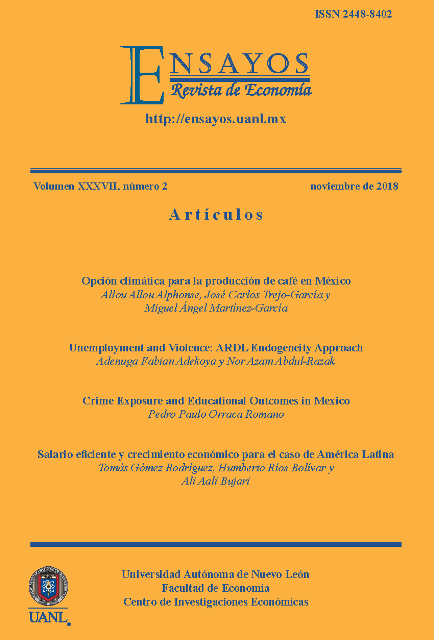Crime Exposure and Educational Outcomes in Mexico (Violencia y desempeño académico en México)
DOI:
https://doi.org/10.29105/ensayos37.2-3Palabras clave:
Crime, Academic Performance, Homicide, MexicoResumen
Driven by drug-related crimes, homicide levels in Mexico have dramatically increased since 2007. This study examines the effect of students’ exposure to crime on educational outcomes in Mexico. Using school-level data, a panel of the country’s elementary and secondary schools is constructed to analyse the effect of local homicides on standardised test scores and grade failure rates. The results show that a one-unit increase in the homicide rate per 10,000 inhabitants is associated with a reduction in school-level test scores between 0.0035 and 0.0142 standard deviations, this is likely being driven by effects of individual test scores and by compositional changes in the student body. Additionally, a rise in the homicide rate is also associated with an increase in the grade failure rate. It is proposed that the negative effects of crime exposure are partly due to a reduction of the number of contact hours, and students not compensating for this, by studying more outside of school. Exposure to homicides has potentially long-term consequences since it may affect educational achievement levels and future income flow.
RESUMEN
Debido a un aumento en el número de delitos relacionados con el crimen organizado, los niveles de homicidios en México se incrementaron drásticamente a partir de 2007. Este artículo estudia los efectos de la exposición a altos niveles de homicidios sobre los logros educativos en México. Para ello, se construye un panel de escuelas primarias y secundarias a fin de analizar los efectos de los homicidios sobre los resultados de la prueba ENLACE y la tasa de reprobación. Los resultados muestran que un aumento en una unidad en la tasa de homicidios por cada 10,000 habitantes está asociado con una reducción en los resultados de la prueba ENLACE entre 0.0035 y 0.0042 desviaciones estándar, donde estos hallazgos son producto del efecto negativo sobre los resultados de la prueba y del cambio en la composición estudiantil dentro de las escuelas. Asimismo, incrementos en los niveles de homicidios también están asociados con un aumento en la tasa de reprobación. Los efectos negativos generados por los homicidios son, en parte, producto de una reducción en el número de horas que los alumnos asisten a la escuela.
Descargas
Citas
Abouk, R. and Adams, S. (2013). “School shootings and private school enrolment”. Economics Letters, 118, 297-299.
Balmori, J. (2014). Three essays on law and development in Mexico. (Doctoral Dissertation). Cornell University, Ithaca.
Basu, S. and Pearlman, S. (2017). “Violence and migration: evidence from Mexico’s drug war”. IZA Journal of Development and Migration, 7, 18.
Brown, R. and Velásquez, A. (2017). “The effects of violent crime on the human capital accumulation of young adults”. Journal of Development Economics, 127, 1-12.
Castillo, J., Mejía, D., and Restrepo, P. (2014). “Scarcity without Leviathan: The violent effects of cocaine supply shortages in the Mexican drug war”. Center for Global Development Working Paper No. 356.
Caudillo, M. and Torche, F. (2014). “Exposure to local homicides and early educational achievement in Mexico”. Sociology of Education, 82, 89-105.
Chamarbagwala, R. and Morán, H. (2011). “The human capital consequences of civil war: Evidence from Guatemala”. Journal of Development Economics, 94, 41-61.
Dell, M. (2015). “Trafficking networks and the Mexican drug war”. American Economic Review, 105, 1738-1779.
Ding, W., Lehrer, S., Rosenquist, N., and Audrain-McGovern, J. (2009). “The impact of poor health on academic performance: New evidence using genetic markers”. Journal of Health Economics, 28, 578-597.
Dube, A., Dube, O., and García-Ponce, O. (2013). “Cross-border spillover: U.S. gun laws and violence in Mexico”. American Political Science Review, 107, 397-417.
Duran-Martinez, A. (2015). “To kill and tell? State power, criminal competition and drug violence.” Journal of Conflict Resolution, 59, 1377-1402.
Enamorado, T., López-Calva, L., and Rodríguez-Castelán, C. (2014). “Crime and growth convergence: Evidence from Mexico”. Economics Letters, 125, 9-13.
Gerardino, M. (2014). The effect of violence on the educational gender gap. Unpublished manuscript.
Grogger, J. (1997). “Local violence and educational attainment”. Journal of Human Resources, 32, 659-682.
Guerrero-Gutiérrez, E. (2011). Security, drugs, and violence in Mexico: A survey. Paper presented at the 7th North American Forum Meeting, Washington, D.C.
Harding, D. (2010). Living in the Drama: Community, Conflict, and Culture among Inner-City Boys. Chicago, IL: University of Chicago Press.
INEGI (2012). Resultados de la ENVIPE 2012. Boletín de prensa núm. 339/12. Aguascalientes: INEGI.
Justino, P., Leone, M., and Salardi, P. (2014). “Short- and long-term impact of violence on education: The case of Timor-Leste”. World Bank Economic Review, 28, 320-353.
León, G. (2012). “Civil conflict and human capital accumulation: The long-term effects of political violence in Perú”. Journal of Human Resources, 47, 991-1022.
Márquez-Padilla, F., Pérez-Arce, F., and Rodríguez-Castelán, C. (2015). “The (non-) effect of violence on education: Evidence from the “war on drugs” in Mexico”. World Bank Working Paper No. 7230.
Michaelsen, M. and Salardi, P. (2015). Violence, psychological stress and educational performance in Mexico. Paper presented at the Pacific Conference for Development Economics, San Diego.
Monteiro, J. and Rocha, R. (2017). “Drug battles and school achievement: Evidence from Rio de Janeiro’s favelas”. Review of Economics and Statistics, 99(2), 213-228.
O'Neil, S. (2009). “The real war in Mexico: How democracy can defeat the drug cartels”. Foreign Affairs, 88(4): 63-77.
Osofsky, H., Osofsky, J., Sklarew, B., Twemlow, S., and Wilkinson, S. (2004). Children’s exposure to community violence: Psychoanalytic perspectives on evaluation and treatment. In Sklarew, B., Twemlow, S., and Wilkinson, S. (Eds.), Analysts in the Trenches: Streets, Schools, War Zones (pp. 237-256). Abingdon: Routledge.
Policía Federal (2015). Oficio PF/OCG/DGE/0083/2015. México: Policía Federal. Oficina del Comisionado General. Dirección General de Enlace.
PGR (2014). Oficio: SJAI/DGAJ/00826/2014. México: Procuraduría General de la República. Subprocuraduría Jurídica de Asuntos Internacionales. Dirección General de Asuntos Jurídicos.
Poutvaara, P. and Ropponen, O. (2018). “Shocking news and cognitive performance”. European Journal of Political Economy, 51, 93-106.
Rios, V. (2014). “The role of drug violence and extortion in promoting Mexican migration: Unexpected consequences of a drug war”. Latin American Research Review, 49, 199-217.
Robles, G., Calderón, G., and Magaloni, B. (2015). “The economic consequences of drug trafficking violence in Mexico”. Stanford University Working Paper.
Sampson, R., Raudenbush, S., and Earls, F. (1997). “Neighborhoods and violent crime: A multilevel study of collective efficacy”. Science, 277, 918-924.
Shemyakina, O. (2011). “The effect of armed conflict on accumulation of schooling: Results from Tajikistan”. Journal of Development Economics, 95, 186-200.
UNODC (2014). World Drug Report. Vienna: United Nations Office on Drugs and Crime.
World Bank (2014). World Development Indicators. Washington, DC: World Bank.
Archivos adicionales
Publicado
Cómo citar
Número
Sección
Licencia
Derechos de autor 2018 Pedro Paulo Orraca Romano

Esta obra está bajo una licencia internacional Creative Commons Atribución 4.0.
















